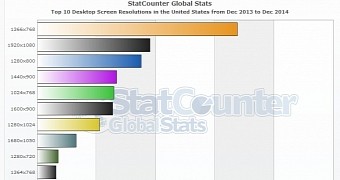Today's devices come with insanely big screen resolutions (just look at the monitors unveiled by HP at CES 2015 – they all have an ultra HD resolution of 3840x2160 pixels), but stats show that most users out there continue to stick to devices with smaller screens obviously offering lower resolutions.
Data provided to us by StatCounter for the last year and regarding the US market shows that the top resolution that Americans used last year is 1366x768px, which, according to these figures, was used by 20.26 percent of the Internet users in the country.
The 1920x1080px resolution is also very common in the United States, but below what some analysts and manufacturers expected. Only 11.4 percent of the Americans had a screen capable of reaching this resolution in 2014.
1024x768px still surprisingly popular
At the same time, 1280x800px and 1440x900px resolutions, both of which are mostly used by laptops, are also among the top configurations for many desktop monitors out there, with shares of 10.52 and 8.05 percent, respectively.
And what's even more surprising is that 1024x768px, which is the lowest resolution supported by modern operating systems (Windows 8 does support it, but with some feature limitations), continues to be used on lots of computers in the United States, with stats pointing to a 7.77 percent share in 2014.
In 2014, the screen resolution with the smallest number of users was the 1364x768px configuration, which, according to StatCounter, was only applied on 1.9 percent of the monitors.
Unfortunately for manufacturers, the highest resolution in the chart is 1920x1080px, so it's pretty clear that the masses didn't invest too much in high-definition computer screens in 2014.
Does this reflect the poor sales experienced by the PC industry as well? It probably does, especially because most PC makers in the world reported either drops or only slight improvements in new PC shipments last year, as the industry still hasn't recovered after the collapse started in 2010.
All these figures are collected from desktop computers and laptops, so they do not include tablets, which usually have lower resolutions.

 14 DAY TRIAL //
14 DAY TRIAL //